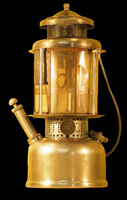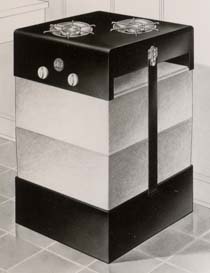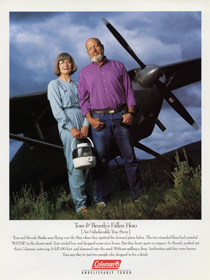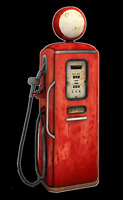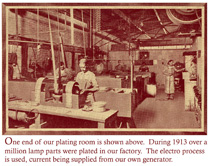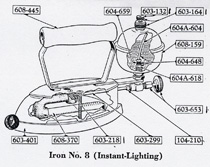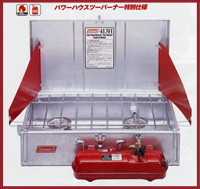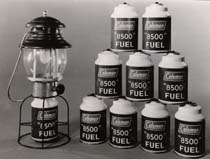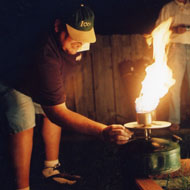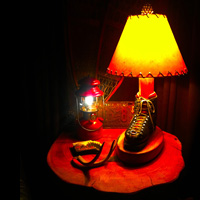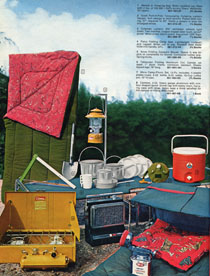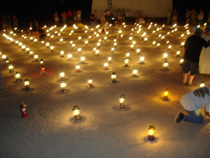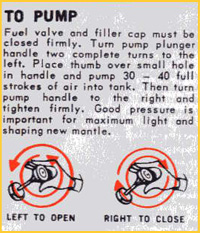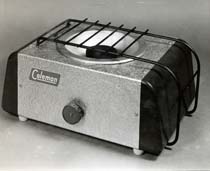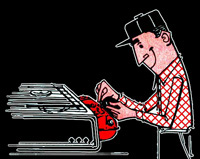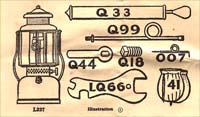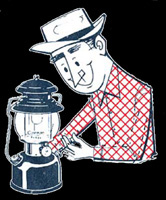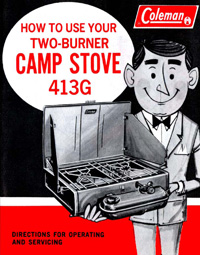 Rebuilding Coleman® Two or Three Burner Stoves
Rebuilding Coleman® Two or Three Burner Stoves
Chapter Two: Cleaning
There are lots of ways to clean a stove. I'm going to show you how I learned to do it over the years.
![]() If you have questions about any method I use during this chapter, click here to review the section dedicated to cleaning.
If you have questions about any method I use during this chapter, click here to review the section dedicated to cleaning.
![]() The sequence of cleaning parts is not important, but I recommend that you start with items that will take a little longer to finish.
The sequence of cleaning parts is not important, but I recommend that you start with items that will take a little longer to finish.
2.1 Separate everything into groups. Because there are so many parts to clean and prepare for re-use, it's always best to group them by how they will be cleaned. Start by separating into these groups:
a. The painted stuff. The case and tank were painted by the factory and they get cleaned separately. Don't forget that the lid leg is painted, as is the fuel filler cap and screw.
b. Non-brass metal parts. This includes parts of the burner, all of the clips and nuts, the legs, handle, etc.
c. Brass parts. Includes nearly all of the fuel valve.
d. The grate(s) and drip tray will be the dirtiest, and are cleaned separately.
e. Everything else. The plastic valve stem wheel, the leather pump cup, etc.
2.2 Cleaning and preparing the pump assembly. Locate your pump, or all of the pieces to your pump, and lay them out on your workbench. Spray everything down with carburetor cleaner. Use brushes and soft rags to remove the grease and dirt. Cotton swabs work well in removing the dirt on the underside of the pump cap where it contacts the tank.
![]() Caution: The plating on the pump cap is very thin. Do not scrub the cap with a metal brush, especially using carburetor cleaner. If it has excessive grease/oil on it that doesn't come off fairly easily, I recommend using a household cleaner rather than the carburetor cleaner.
Caution: The plating on the pump cap is very thin. Do not scrub the cap with a metal brush, especially using carburetor cleaner. If it has excessive grease/oil on it that doesn't come off fairly easily, I recommend using a household cleaner rather than the carburetor cleaner.
If you disassembled the pump eariler, reassemble it now. Slide the pump cap and return spring on the pump shaft. Thread the backing plate on to the bottom of the shaft with the raised side facing towards the bottom. Snug with pliers. Install the pump cup on the end of the pump and center it on the backing plate. Install the lock nut or push-on nut to secure it.
Fold back the outer edges of the pump cup to shape it like an umbrella as shown in Figure 1. Lower the pump cup down into a small container of Neatsfoot oil, or an other light oil. I have used 3-in-1 oil, sewing machine oil and even motor oil and they all worked fine. Keep the pump cup submerged in the oil (Figure 2) for at least an hour.
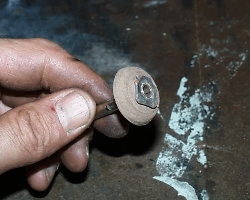 |
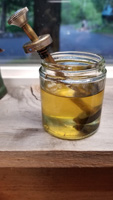 |
Figure 1 |
Figure 2 |
![]() If a previous owner of your stove replaced the pump assembly with a cheap replacement with a neoprene pump cup, I recommend you source a vintage pump and use a leather pump cup.
If a previous owner of your stove replaced the pump assembly with a cheap replacement with a neoprene pump cup, I recommend you source a vintage pump and use a leather pump cup.
2.10 Cleaning the fuel filler cap. The original cap should match your tank. You'll clean the original cap (and screw if applicable) next with your tank. I recommend you always use a new filler cap when operating any stove or lantern.
To remove the old filler cap gasket, you burn it out of the insert with a propane torch. Instructions on removing and replacing one can be found here.
2.5 Cleaning the inside of the tank. You probably have rust and/or sludge in your tank, and now is the time to get it out. With the valve out of the tank, you can use a small flashlight to look inside to see how much there is. If you see a lot of rust around the fuel filler cap, that usually means more is below it.
I have successfully used common household products to remove rust from tanks and founts for years. I listed white vinegar in the "tools and supplies" list for this chapter, and it will remove rust. There are also a number of products on the market specifically designed for this task and the one I recommend is Evapo-Rust®. Unlike vingegar, this product will not etch metal and is much safer to use.
Whatever product(s) you use to clean the inside of the tank, remember that bare metal will rust immediately if exposed to air and water. Once you are finished with the cleaning process, it is really important to get all of the moisture out of the tank. If you don't, you'll need a second opportunity to clean it.
Specific instructions on cleaning with scary household products like acetic acid, sulfamic acid, sulfuric acid and even citric acid can be found here.
 Acids can burn you. Please use with caution and read the manufacturer’s warning labels before using. Click here to access our Safety Data Sheet (SDS) pages for additional information.
Acids can burn you. Please use with caution and read the manufacturer’s warning labels before using. Click here to access our Safety Data Sheet (SDS) pages for additional information.
2.6 Cleaning the outside of the tank. Removing the external grease, dirt and grime from a stove tank takes time. Unfortunately the tank catches the brunt of sloppy cooking, and over time it usually discolors the paint.
Start by spraying the tank down with a household cleaner. Be sure to spray the inside of the pump cylinder too. Take a soft damp rag and gently remove as much dirt and grime as you can. If you have a heavy black deposit (varnish) on the tank, take your time and get it off with cleaner.
Use a toothbrush to scrub the inside of the pump cylinder until it feels smooth. Hold the tank on end and spray the cleaner up inside to rinse the grime out.
Use the toothbrush to clean the grime from the flaps and the seam around the tank.
Open a can of automotive rubbing compound and spray in some cleaner to soften it up. Lightly dab the toothbrush into the rubbing compound and use it to clean around the fuel filler hole, the pump cylinder hole and the seam. Use a soft damp rag and a circular motion to apply rubbing compound to the rest of the tank.
With a clean soft rag, rub the dried rubbing compound off the tank and buff to a shine. If the compound does not want to come off, give it a quick spray of household cleaner and try again. Use a dry brush for the pump cylinder, filler hole and seam. Follow this with polishing car wax to really make it shine. The before and after can be seen as Figure 7 and Figure 8.
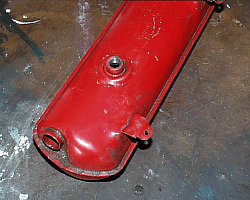 |
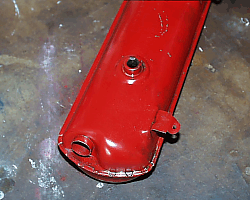 |
Figure 7 |
Figure 8 |
2.4 Cleaning the brassy parts. Gather all of the brass parts that you previously removed from your tank. This will include the fuel valve body, the fuel and air tube, valve stem, valve stem nut and packing retainer (Figure x). The gas tip and gas tip protector from your generator are also made of brass as are the check valve and the air stem.
Removing soot and grime from brass is easily accomplished with chemicals and brushes. An hour-long soak in white vinegar (acetic acid) will do the trick in most cases. Naval jelly (phosphoric and sulfuric acid) is another easy way to clean dirty brass.
![]() Warning: There is a graphite packing inside of the valve body that should not be submerged in liquid. This also applies to the valve stem nut, if you left the packing in it.
Warning: There is a graphite packing inside of the valve body that should not be submerged in liquid. This also applies to the valve stem nut, if you left the packing in it.
Take all of your brass parts (except for the valve body and valve stem nut if you left the packing in) and place them in a small bowl (Figure x). Fill with white vinegar and allow the parts to soak for an hour or so. After the soak, spray the parts with carburetor cleaner, scrub with a brush and then wipe them off with a rag. White vinegar may give the brass a pink or red hue.
Coat the valve body (and valve stem nut if applicable) with naval jelly as in (Figure x). If you don't have naval jelly you make a paste mixture of vinegar and baking soda. This will clean the brass but won't damage the graphite packing. Allow the goop to sit on the valve body for an hour or so, then gently clean it with brushes and a rag.
Use 0000 steel wool to induce a shine on cleaned brass parts, if desired.
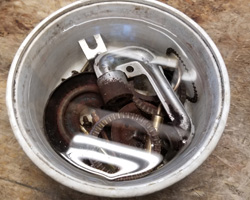 |
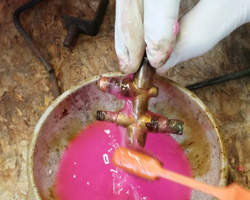 |
Figure 1 |
Figure 2 |
2.4 Cleaning the fuel and air tube
Get your fuel and air tube and valve body from the pile of cleaned brass parts. Hold the fuel and air tube in one hand and spray carburetor cleaner into the large end as in Figure 5. Now turn the tube around and insert the valve's metering rod to plunge the fuel tube from the bottom. Move it in and out numerous times to dislodge any varnish inside the tube.
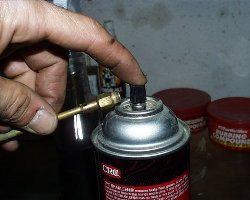 |
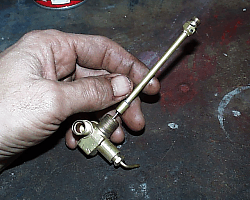 |
Figure 5 |
Figure 6 |
Blow compressed air into the bottom to remove the cleaner and corrosion. If you don't have an air compressor, shake the tube with the large end down to remove as much cleaner as you can, then blow through the tube from the bottom as hard as you can.
Clean the metering rod with steel wool and wipe it clean with a cloth. Once you have finished this, install the fuel tube over the metering rod and snug it up with a wrench. Set the valve aside.
2.7 Cleaning the bare metal parts. This includes the rest of the smaller parts and pieces of the stove to include all the nuts & bolts, the burner assembly, legs, handles, drip tray and grates.
The best way to clean the bare metal parts and pieces of your stove is by soaking them in a cleaning solution, followed by removal of the rust and grime with metal brushes. Use can use vinegar or Evapo-Rust® for this.
![]() Do NOT leave parts soaking in vinegar unattended or overnight as it is acidic and will etch the metal. Keep an eye on things and remove pieces from the solution as soon as they are ready.
Do NOT leave parts soaking in vinegar unattended or overnight as it is acidic and will etch the metal. Keep an eye on things and remove pieces from the solution as soon as they are ready.
![]() Parts can be left soaking in Evapo-Rust® for long periods of time, even overnight, without damage.
Parts can be left soaking in Evapo-Rust® for long periods of time, even overnight, without damage.
Find an appropriately sized plastic container and place the bare metal parts inside. Fill the container with your preferred cleaning solution up to the point where everything is completely submerged.
After soaking, clean each individual part with metal brushes and rags. Rinse them off in water and dry immediately, or spray them with WD-40® and wipe off the excess.
The grate(s) on your stove may or may not require special cleaning, depending on age and condition.
a. For newer or very clean stoves, the easy way to get the grate(s) clean is with oven cleaner. Scrub with a stiff wire brush, just as you would your BBQ grill.
b. The really dirty and/or rust ones come clean with a long soak in vinegar or Evapo-Rust®, followed by a good scrubbing with a stiff steel (welding) brush. This takes much effort but is worth it.
When clean, apply a coat of vegetable oil to the grate(s) to prevent rust.
2.8 Cleaning the case & lid. This is an area that unfortunately might not come out as well as we’d like. Old stoves are usually coated with dried grease that hardened to the paint years ago. I have not found a fool-proof method of removing the grease while leaving the paint intact. I can tell you that harsh cleaners, kitchen scrubbers and even prolonged soaking in soapy water will destroy the paint.
The trick to cleaning a painted stove case/lid is with heat andThe best way I have found to clean them is a good household cleaner like Simple Green®, warm water and a soft rag or sponge. Once you are finished, rinse the case off and allow it to dry. Wiping it down with a product like Armor All® helps bring back some of the shine.
![]() Caution: Be very careful in cleaning the case. There are razor sharp edges inside and they will cut you.
Caution: Be very careful in cleaning the case. There are razor sharp edges inside and they will cut you.
2.9 Clean the steel parts. Separate the burner tubes from the burner boxes and U-tube by unscrewing them. Soak the entire manifold in hot soapy water for 15 minutes or so and then allow to dry.
Coat the outside of each piece with naval jelly and allow them to soak for 30 minutes or so. Use a small metal brush and warm water to clean them. Allow to dry.
2.11 Clean the valve wheel. Soak the valve wheel with a household cleaner, then clean with a toothbrush and a soft rag. Must of the grease will be on the back side so clean it well there.
2.12 Rust Protection. Because many of your stove parts are steel, they are susceptible to rust. These parts leave the factory painted, but the paint is often destroyed after years of use.
I recommend you gather the following parts and apply a high-temperature silver paint to protect them from rust: manifold, burner bowls, burner caps, burner screws, burner boxes and the nuts & bolts used to attach the manifold to the case. You may also want to paint the drip tray (Figure 9).
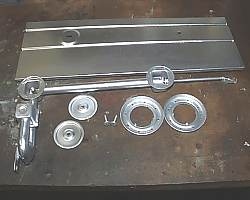 |
Figure 9 |
Your stove is now clean and is ready for re-assembly.


